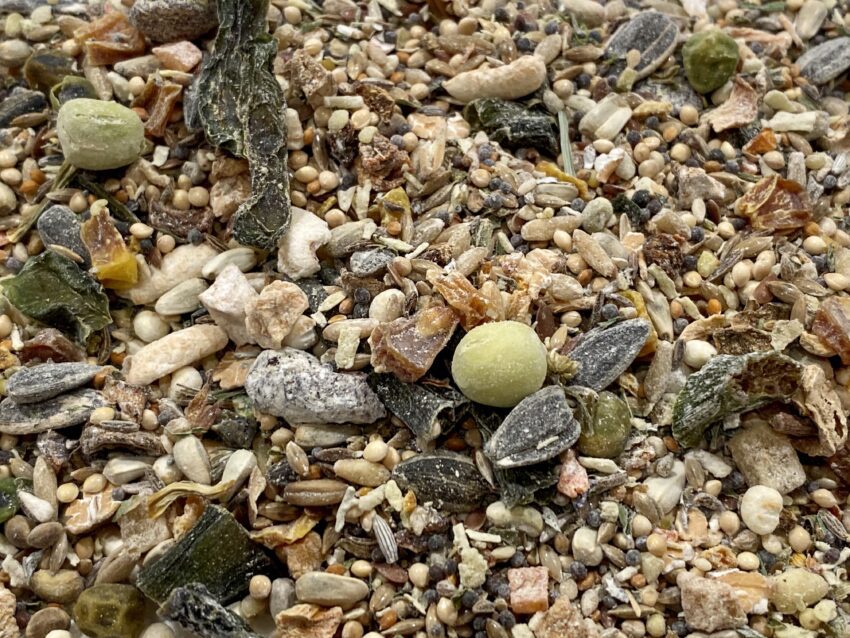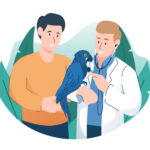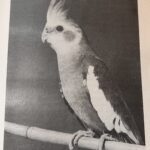
Seeds and “bad fat”
Primarily in the United States, the conventional wisdom is that seed diets are bad because they are high in fat. As a result, they will lead to obesity, poor feather condition, and chronic diseases. I’ve written many articles providing research that debunks this wisdom that is hammered into us by doctors, vets, bird keepers, and bird rescue organizations.
Here is everything I’ve written about fat, but one article called “Are seeds high in fat?” is particularly relevant here.
In that article, I estimated the fat content of some popular Kaytee mixes for six parrot species:
Cockatiel: Canary grass, millet, safflower (17% fat)
Parakeet: Canary grass, millet, oats (14%)
Lovebird: Sunflower, canary grass, millet (44%)
Macaw: Sunflower, safflower, pumpkin (55%)
Finch: Millet, canary grass, oats (10%)
Conure: Millet, safflower, sunflower (21%)
Seeds considered “high fat” are marked in bold. As I mentioned in my article called “The real reason the ‘all seed’ diet is bad“, the recommended fat percentages for humans fall in the 20-40% range.
“Good” and “bad” fat
In the past decade, especially, the focus has moved from demonizing all fat to dividing fat into “good” and “bad” fats. Here is one summary of the conventional wisdom:
Unsaturated fats, which are liquid at room temperature, are considered beneficial fats because they can improve blood cholesterol levels, ease inflammation, stabilize heart rhythms, and play a number of other beneficial roles. Unsaturated fats are predominantly found in foods from plants, such as vegetable oils, nuts, and seeds.
Types of Fat | The Nutrition Source | Harvard T.H. Chan School of Public Health
Monounsaturated and polyunsaturated fat (which includes omega-3 fats) are consider “good” fat and saturated fat is considered “bad” fat. This has been pretty solidly debunked in many studies, including this one mentioned in my article called “Animal research into fat, carbohydrates, and disease“:
High carbohydrate intake was associated with higher risk of total mortality, whereas total fat and individual types of fat were related to lower total mortality. Total fat and types of fat were not associated with cardiovascular disease, myocardial infarction, or cardiovascular disease mortality, whereas saturated fat had an inverse association with stroke. Global dietary guidelines should be reconsidered in light of these findings.
Associations of fats and carbohydrate intake with cardiovascular disease and mortality in 18 countries from five continents (PURE): a prospective cohort study—The Lancet—August 29, 2017
So fat doesn’t contribute to our mortality, even the “bad fat”.
BUT!
For the sake of discussion, let’s presume that the conventional wisdom is correct: eat a minimal amount of fat and make sure it’s mostly unsaturated fat. The Harvard School of Public Health recommends no more than 10% of calories come from “bad” fat.
So, let’s go back to our seed mixes. Here are some of the common seeds that are considered high fat: sunflower, safflower, hemp, flax, and pumpkin. So what is the mix of “good” and “bad” fats in these seeds?
| Type of seed | Saturated ("bad") fat as % of total calories |
|---|---|
| (Recommended maximum) | (10%) |
| Sunflower | 7% |
| Flax | 7% |
| Hemp | 6% |
| Safflower | 6% |
So, even if we believe in the concept of “bad” fats, only pumpkin seed has a “bad” fats content higher than the 10% threshold, while the rest is comfortably below.
However!
It’s important to note that these numbers assume each seed comprises the entire diet. So, for example, if your bird eats 100% pumpkin seeds, 20% of the calories are from “bad” fats. But few ready-made seed mixes contain even a small fraction of pumpkin seeds. All the other seeds are so far below the recommended percentage that it’s not even worth thinking about that scenario.
Sunflower seeds are often held up as the poster child for bad parrot diets, but a nutrient analysis reveals it’s not got enough “bad” fats (8%) to be of any concern. If you’re concerned about them. Which I’m not. 🙂

